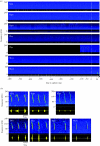Breaking the trade-off: rainforest bats maximize bandwidth and repetition rate of echolocation calls as they approach prey
- PMID: 20356884
- PMCID: PMC2936139
- DOI: 10.1098/rsbl.2010.0114
Breaking the trade-off: rainforest bats maximize bandwidth and repetition rate of echolocation calls as they approach prey
Abstract
Both mammals and birds experience a performance trade-off between producing vocalizations with high bandwidths and at high repetition rate. Echolocating bats drastically increase repetition rate from 2-20 calls s(-1) up to about 170 calls s(-1) prior to intercepting airborne prey in order to accurately track prey movement. In turn, bandwidth drops to about 10-30 kHz for the calls of this 'final buzz'. We have now discovered that Southeast Asian rainforest bats (in the vespertilionid subfamilies Kerivoulinae and Murininae) are able to maintain high call bandwidths at very high repetition rates throughout approach to prey. Five species of Kerivoula and Phoniscus produced call bandwidths of between 78 and 170 kHz at repetition rates of 140-200 calls s(-1) and two of Murina at 80 calls s(-1). The 'typical' and distinct drop in call frequency was present in none of the seven species. This stands in striking contrast to our present view of echolocation during approach to prey in insectivorous bats, which was established largely based on European and American members of the same bat family, the Vespertilionidae. Buzz calls of Kerivoula pellucida had mean bandwidths of 170 kHz and attained maximum starting frequencies of 250 kHz which makes them the most broadband and most highly pitched tonal animal vocalization known to date. We suggest that the extreme vocal performance of the Kerivoulinae and Murininae evolved as an adaptation to echolocating and tracking arthropods in the dense rainforest understorey.
Figures


References
-
- Britton A. R. C., Jones G.1999Echolocation behaviour and prey-capture success in foraging bats: laboratory and field experiments on Myotis daubentonii. J. Exp. Biol. 202, 1793–1801 - PubMed
-
- Draganoiu T. I., Nagle L., Kreutzer M.2002Directional female preference for an exaggerated male trait in canary (Serinus canaria) song. Proc. R. Soc. Lond. B 269, 2525–2531 (doi:10.1098/rspb.2002.2192) - DOI - PMC - PubMed
-
- Griffin D. R., Webster F. A., Michael C. R.1960The echolocation of flying insects by bats. Anim. Behav. 8, 141–154 (doi:10.1016/0003-3472(60)90022-1) - DOI
-
- Hoofer S. R., Van den Bussche R. A.2003Molecular phylogenetics of the chiropteran family Vespertilionidae. Acta Chiropterol. 5, 1–59
-
- Kalko E. K. V.1995Insect pursuit, prey capture and echolocation in pipistrelle bats (Microchiroptera). Anim. Behav. 50, 861–880 (doi:10.1016/0003-3472(95)80090-5) - DOI
Publication types
MeSH terms
LinkOut - more resources
Full Text Sources
Miscellaneous

